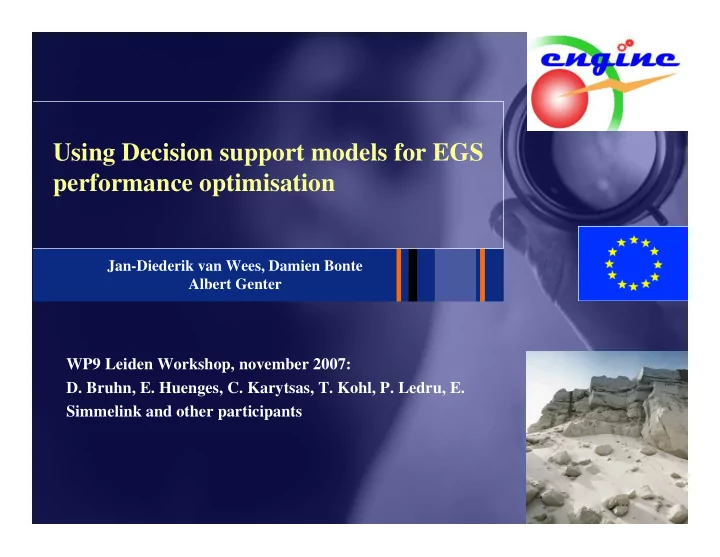

Using Decision support models for EGS performance optimisation Jan-Diederik van Wees, Damien Bonte Albert Genter WP9 Leiden Workshop, november 2007: D. Bruhn, E. Huenges, C. Karytsas, T. Kohl, P. Ledru, E. Simmelink and other participants
Leiden Workshop: three aspects to performance • Make the project fly economically � � � � techno-economic assessment � � � EXCEL � • Constraints for the project by government (e.g. induced earthquakes within limits � � � � HAZOP, contingency plans) • Legislation and PR bottlenecks (delaying t first electricity ) Leiden workshop, november 2007 ENGINE final meeting 2
AIM of future research � � � � bring UTC below 15cts/kWh 1 cts/kWh 1 cts/kWh Unit Technical Cost � Unit Technical Cost � 15 cts/kWh 15 cts/kWh 30 cts/kWh 30 cts/kWh Risk ( Costs*P(UTC>15cts) ) � Risk ( Costs*P(UTC>15cts) ) � ENGINE final meeting 3
Contents • Performance calculation -EXCEL • Taking into account uncertainties and engineering options • Best practices Asset development decisions E&P • Decision support system • Applications to EGS ENGINE final meeting 4
CO- CashFlow UCF = Cash in - Cash out 30 Revenues DCF (DISCOUNT_RATE) 20 10 t first-electricty Cash flow (M � ) Production NPV 0 1 2 3 4 5 Time (years) -10 Pay out time -20 � � � � DCF -30 Opex + Capex ENGINE final meeting 5
Techno-ecomonic calculation � � � � Fast computational models Indicators Technical Economic NPV Toutlet DPR, IRR Well design Max. Exposure Payout Time Econ. Lifetime Unit Technical Cost BAS UD SD CF basin Underground Surface Economics properties development development driving philosophy is to trade-off accuracy for completeness ENGINE final meeting 6
FAST ANALYTICAL MODEL for EGS, EXCEL ENGINE final meeting 7
Brief explanation of rationale behind these models Streamline approach for fracture flow (Pruess and Bodvarsson, 1983; Heidinger et al., 2006) Area of fractures (A) and flow rate (Q) and Number of fractures (N) primarily relate to the sustainibility in time of the high temperatures. � � � � � � Narea c � � � � Seg G G G � � � � c ( Q ) � � � � � F seg T T ( T T ) erfc � � out _ res G G in _ res � t tdel � � � � � � ENGINE final meeting 8
Brief explanation of rationale behind these models Circulation test : • II: L/s MPa at res • PI: l/s MPa at res Target flowrate � � � � • injection+production pumps PI • friction and thermal II expansion Model based on fracture flow (Pruess and Bodvarsson, 1980; Heidinger et al., 2006) ENGINE final meeting 9
FAST ANALYTICAL MODEL for EGS, EXCEL 1.00E+00 Temperatures in the production well 9.00E-01 210 8.00E-01 200 190 7.00E-01 psi=0 (BORDER) 180-150 Temperature 180 6.00E-01 150-120 120-90 170 5.00E-01 90-60 160 60-30 4.00E-01 30-0 150 3.00E-01 0 140 2.00E-01 1 2 3 4 5 6 7 8 9 10 11 12 13 14 15 16 17 18 19 20 21 22 23 24 25 26 27 28 29 30 Time 1.00E-01 Bottom of the production well Top of the production well 0.00E+00 0.00E+00 2.00E-01 4.00E-01 6.00E-01 8.00E-01 1.00E+00 1.20E+00 ENGINE final meeting 10
Taking into account uncertainties and engineering options TNOs experience from Oil and Gas E&P “Decision and risk management” Research consortia (1997-2003) BHPBilliton AND Scenarios vs. Continuous probability functions (MC) • ENGINE final meeting 11
DSS model : Mixing discrete and continuous uncertainties, decision trees • Design decision (discrete) • Normal plant (costs 1.5 mln/ MWe, eff=0.68) • Higheff plant (costs 2 mln/ MWe, eff=0.8) • Uncertainties (continuous) • Fracture area 2-4 km2 • Inflow other than “connected” fracture 50-90% • Uncertainties (discrete) • Having 1 (80%) ,2 or 3 fractures (each 10%) ENGINE final meeting 12
NPV ENGINE final meeting 13
-1.8 1 2.32 ENGINE final meeting 14
Introducing an information acquisition phase, which allows to rule out N1 Costs are 250 kEURO -0.25 -0.25 ENGINE final meeting 15
0.13 1.66 -0.25 -0.25 NPV 2.32 1 ENGINE final meeting 16
Inflow_other -0.971 [50 .. 90%] Fracture_area -0.155 [2.. 4 km2] ENGINE final meeting 17
ENGINE final meeting 18
ENGINE final meeting 19
AIM of future research � � � � bring UTC below 15cts/kWh 1 cts/kWh 1 cts/kWh Unit Technical Cost � Unit Technical Cost � 15 cts/kWh 15 cts/kWh 30 cts/kWh 30 cts/kWh Risk ( Costs*P(UTC>15cts) ) � Risk ( Costs*P(UTC>15cts) ) � ENGINE final meeting 20
Conclusions EGS • Fast models are available in EXCEL • Excel spread-sheet (and DSS) to be distributed as Engine WP9 deliverable. Excel can be easily modified (no black box). DSS fully probabilistic, scenario trees etc. • Models allow to rationalize added value of new research for exploration and production ENGINE final meeting 21
Recommend
More recommend